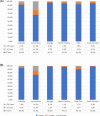COVID-19 Pandemic in Assisted Living Communities: Results from Seven States
- PMID: 32955107
- PMCID: PMC7537218
- DOI: 10.1111/jgs.16850
COVID-19 Pandemic in Assisted Living Communities: Results from Seven States
Abstract
Objective: To describe variations in COVID-19 confirmed cases and deaths among assisted living (AL) residents and examine their associations with key AL characteristics.
Design: Observational study employing data on confirmed COVID-19 cases and deaths in ALs from seven states, through May 29, 2020.
Setting: Information on COVID-19 cases/deaths in ALs was obtained from state government websites. A national inventory of ALs was used to identify communities with and without COVID-19 cases/deaths. Medicare Beneficiary Summary File identifying AL residents was employed to develop AL characteristics. County-level COVID-19 laboratory-confirmed cases/deaths were obtained from publicly available data.
Participants: We found 4,865 ALs (2,647 COVID-19 cases and 777 deaths) in the seven states. After excluding missing data, the sample consisted of 3,994 ALs (82.1%) with 2,542 cases (96.0%) and 675 deaths (86.9%).
Main outcomes and measures: Outcomes were AL-level counts of cases and deaths. Covariates were AL characteristics and county-level confirmed COVID-19 cases/deaths. Multivariable two-part models determined the associations of independent variables with the likelihood of at least one case and death in the AL, and with the count of cases (deaths).
Results: State case fatality ranged from 3.32% in North Carolina to 9.26% in Connecticut, but for ALs in these states it was 12.89% and 31.59%, respectively. Among ALs with at least one case, midsize communities had fewer cases (incidence rate ratio (IRR) = 0.829; P = .004) than small ALs. ALs with higher proportions of racial/ethnic minorities had more COVID-19 cases (IRR = 1.08; P < .001), as did communities with higher proportions of residents with dementia, chronic obstructive pulmonary disease, and obesity.
Conclusions and relevance: ALs with a higher proportion of minorities had more COVID-19 cases. Many of the previously identified individual risk factors are also present in this vulnerable population. The impact of COVID-19 on ALs is as critical as that on nursing homes, and is worth equal attention from policy makers.
Keywords: COVID-19; assisted living; risk factors.
© 2020 The American Geriatrics Society.
Conflict of interest statement
The authors have no conflicts of interest to disclose.
Figures
References
-
- Conlen M, Ivory D, Yourish K, et al. More than 40% of US coronavirus death are linked to nursing homes. New York Times, August 13, 2020. https://www.nytimes.com/interactive/2020/us/coronavirus-nursing-homes.html. Accessed August 13, 2020.
-
- Wiener J, Feng Z, Coots L, Johnson R. What is the effect of dementia on hospitalization and emergency department use in residental care facilities? Washington, DC; 2014. https://aspe.hhs.gov/basic-report/what-effect-dementia-hospitalization-a.... Accessed July 8, 2020.
-
- Caffrey C, Harris‐Kojetin L, Sengupta M. Variation in Residential Care Community Resident Characteristics, by Size of Community: United States, 2014. NCHS data brief. 2015:1–8. - PubMed
-
- Han K, Trinkoff AM, Storr CL, Lerner N, Yang BK. Variation across U.S. assisted living facilities: admissions, resident care needs, and staffing. J Nurs Scholarsh. 2017;49:24‐32. - PubMed
-
- Ungar L, Hancock J. COVID‐19 crisis threatens beleaguered assisted living industry. 2020. https://khn.org/news/covid-19-crisis-threatens-beleaguered-assisted-livi.... Accessed May 1, 2020.
Publication types
MeSH terms
Grants and funding
LinkOut - more resources
Full Text Sources
Medical
Miscellaneous


